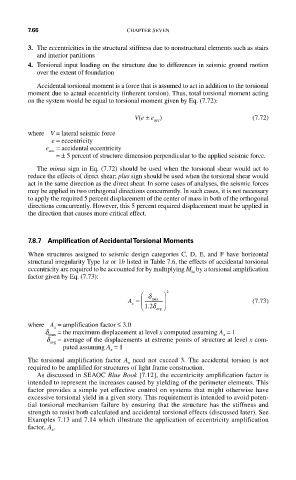Page 504 - Design of Reinforced Masonry Structures
P. 504
7.66 CHAPTER SEVEN
3. The eccentricities in the structural stiffness due to nonstructural elements such as stairs
and interior partitions
4. Torsional input loading on the structure due to differences in seismic ground motion
over the extent of foundation
Accidental torsional moment is a force that is assumed to act in addition to the torsional
moment due to actual eccentricity (inherent torsion). Thus, total torsional moment acting
on the system would be equal to torsional moment given by Eq. (7.72):
V(e ± e ) (7.72)
acc
where V = lateral seismic force
e = eccentricity
e = accidental eccentricity
acc
= ± 5 percent of structure dimension perpendicular to the applied seismic force.
The minus sign in Eq. (7.72) should be used when the torsional shear would act to
reduce the effects of direct shear; plus sign should be used when the torsional shear would
act in the same direction as the direct shear. In some cases of analyses, the seismic forces
may be applied in two orthogonal directions concurrently. In such cases, it is not necessary
to apply the required 5 percent displacement of the center of mass in both of the orthogonal
directions concurrently. However, this 5 percent required displacement must be applied in
the direction that causes more critical effect.
7.8.7 Amplification of Accidental Torsional Moments
When structures assigned to seismic design categories C, D, E, and F have horizontal
structural irregularity Type 1a or 1b listed in Table 7.6, the effects of accidental torsional
eccentricity are required to be accounted for by multiplying M by a torsional amplification
ta
factor given by Eq. (7.73):
⎛ δ ⎞ 2
A = ⎜ max ⎟ (7.73)
x
⎝ .12 δ avg ⎠
where A = amplification factor ≤ 3.0
x
d max = the maximum displacement at level x computed assuming A = 1
x
d = average of the displacements at extreme points of structure at level x com-
avg
puted assuming A = 1
x
The torsional amplification factor A need not exceed 3. The accidental torsion is not
x
required to be amplified for structures of light frame construction.
As discussed in SEAOC Blue Book [7.12], the eccentricity amplification factor is
intended to represent the increases caused by yielding of the perimeter elements. This
factor provides a simple yet effective control on systems that might otherwise have
excessive torsional yield in a given story. This requirement is intended to avoid poten-
tial torsional mechanism failure by ensuring that the structure has the stiffness and
strength to resist both calculated and accidental torsional effects (discussed later). See
Examples 7.13 and 7.14 which illustrate the application of eccentricity amplification
factor, A .
x

